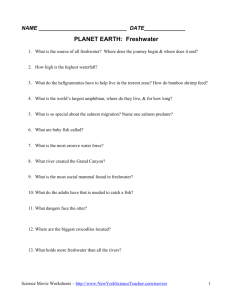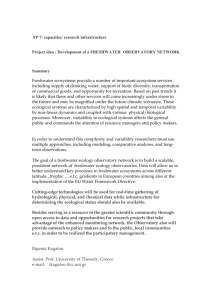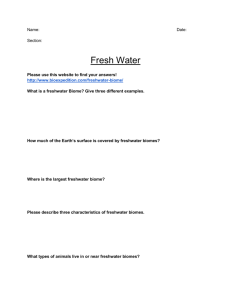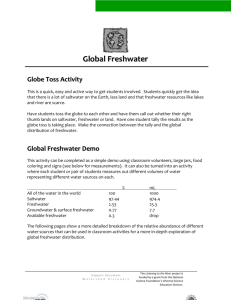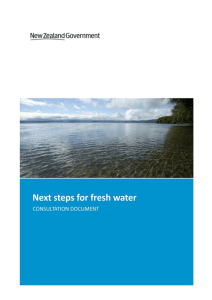Life Science
advertisement
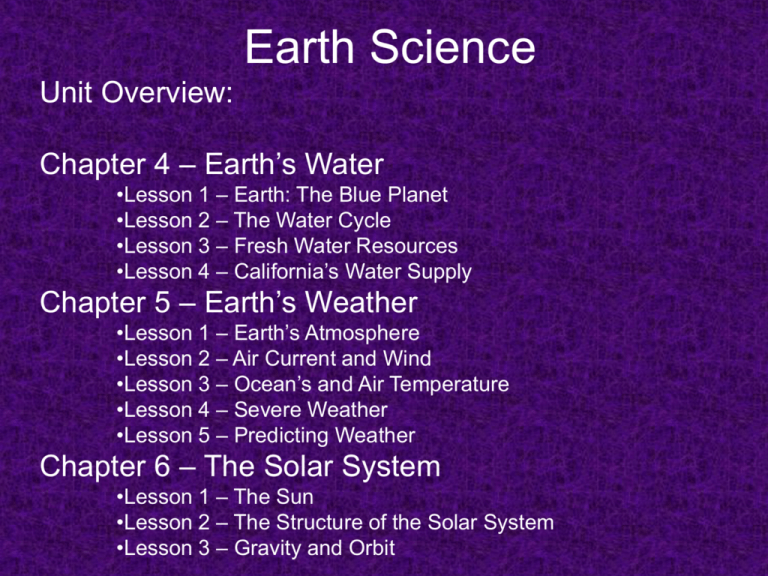
Earth Science Unit Overview: Chapter 4 – Earth’s Water •Lesson 1 – Earth: The Blue Planet •Lesson 2 – The Water Cycle •Lesson 3 – Fresh Water Resources •Lesson 4 – California’s Water Supply Chapter 5 – Earth’s Weather •Lesson 1 – Earth’s Atmosphere •Lesson 2 – Air Current and Wind •Lesson 3 – Ocean’s and Air Temperature •Lesson 4 – Severe Weather •Lesson 5 – Predicting Weather Chapter 6 – The Solar System •Lesson 1 – The Sun •Lesson 2 – The Structure of the Solar System •Lesson 3 – Gravity and Orbit Freshwater Resources Lesson Overview: 1) What do we already know? 2) Vocabulary 3) Drawings 4) Main Ideas 5) Review Earth’s Water: Lesson 3 Page 1 The Water Cycle What do we already know? BrainPOP Teaser 1) What makes water change form? a) Temperature 2) What happens to water after it evaporates? a) turns into water vapor 3) How do clouds form? a) Water vapor condenses to form clouds Earth’s Water: Lesson 3 Page 2 Freshwater Resources: Vocabulary Part I 1) reservoir: a man made lake that is used to store water 2) dam: a structure that stops the natural flow of water 3) groundwater: Any water found beneath the Earth’s surface 4) aquifer: an underground layer of rock or soil that absorbs water Earth’s Water: Lesson 3 Page 3 Freshwater Resources: Vocabulary Part II 5) water table: the area where water collects underground 6) well: A hole drilled into the ground to access water from the water table 7) watershed: the name for an area of land in which water drains into a specific river Earth’s Water: Lesson 3 Freshwater Resources: Vocabulary Part III 8)flood: when water overflows the banks of a river, stream or lake. 9) Contaminate: to dirty or pollute clean water 10) pollute: to dirty or contaminate clean water Page 4 Freshwater Resources: Drawings (pg. 204) Earth’s Water: Lesson 3 Page 5 Freshwater Resources: Main Ideas 1) Where is Earth’s usable fresh water found? (pg. 204-205) a) Ice sheets and glaciers Quick Check (pg. 205) -Critical Thinking: What are some other bodies of water that people can use as a source of water? a) Stream, rivers, lakes, reservoir and water table Earth’s Water: Lesson 3 Page 6 Freshwater Resources: Main Ideas 2) What is a watershed? (pg. 206-207) a) Where the underground water feeds a specific river or lake Quick Check (pg. 207) -Critical Thinking: How could changes made to land far away from a river affect its flow? a) The water in the water table could dry up which would affect the amount of water in a river or lake far away. Earth’s Water: Lesson 3 Page 7 Freshwater Resources: Main Ideas 3) What causes polluted water? (pg. 208-209) a) Oil and gas from vehicles, trash being put into bodies of water, runoff of pollutants Quick Check (pg. 209) -Problem and solution: Why do farmers and homeowners use products that can contaminate fresh water? a) Fertilize plants and lawns, wash cars, killing bugs with insecticides Earth’s Water: Lesson 3 Page 8 Freshwater Resources: Main Ideas 4) How are fresh water resources cleaned? (pg. 210-211) a) We send it through a water treatment plant where it becomes drinkable. Earth’s Water: Lesson 3 Page 9 Freshwater Resources: Review 1) Summarize the main ideas 1) Click to Watch! 2) Think, Talk, and Write Earth’s Water: Lesson 3


